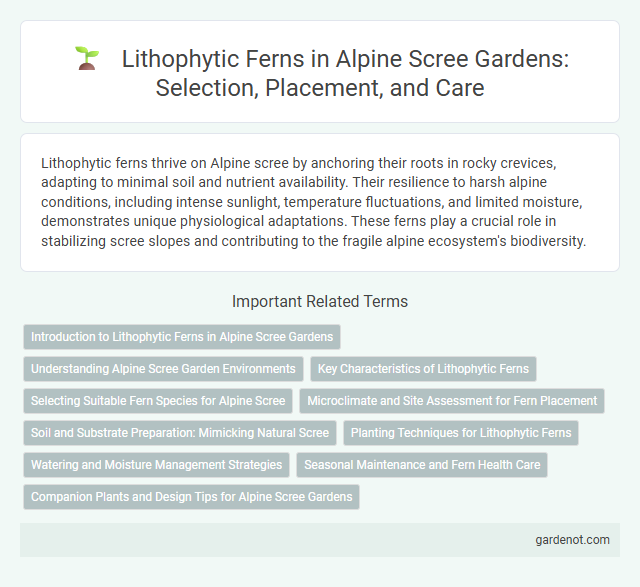Lithophytic ferns thrive on Alpine scree by anchoring their roots in rocky crevices, adapting to minimal soil and nutrient availability. Their resilience to harsh alpine conditions, including intense sunlight, temperature fluctuations, and limited moisture, demonstrates unique physiological adaptations. These ferns play a crucial role in stabilizing scree slopes and contributing to the fragile alpine ecosystem's biodiversity.
Introduction to Lithophytic Ferns in Alpine Scree Gardens
Lithophytic ferns are specialized plants adapted to grow on rocky substrates, thriving in alpine scree environments where soil is minimal and drainage is rapid. These ferns display unique physiological adaptations such as enhanced water retention and nutrient absorption from mineral surfaces. Incorporating lithophytic ferns into alpine scree gardens enhances biodiversity and mimics natural alpine ecosystems, offering resilience against harsh climate and soil conditions.
Understanding Alpine Scree Garden Environments
Lithophytic ferns thrive on rocky alpine scree, adapting to nutrient-poor, well-drained substrates with minimal soil development. These ferns exhibit specialized root structures that anchor into crevices, extracting moisture and nutrients from the mineral-rich rock surfaces. Their presence in alpine scree gardens indicates a unique ecological niche characterized by extreme temperature fluctuations and high exposure to wind and sunlight.
Key Characteristics of Lithophytic Ferns
Lithophytic ferns thrive on rocky surfaces in alpine scree environments, displaying adaptations such as thick, leathery fronds that minimize water loss and anchor tightly to substrates. Their root systems are specialized for extracting nutrients from limited soil deposits within crevices, enabling survival in nutrient-poor, well-drained conditions. These ferns exhibit slow growth rates and high tolerance to temperature fluctuations, crucial for enduring the harsh alpine climate.
Selecting Suitable Fern Species for Alpine Scree
Selecting suitable lithophytic fern species for alpine scree involves prioritizing ferns with strong adaptability to harsh, nutrient-poor, and well-drained rocky substrates typical of high-altitude environments. Species like Asplenium trichomanes and Polypodium vulgare demonstrate resilience through efficient water retention and root systems capable of anchoring in crevices, ensuring survival amid temperature fluctuations and minimal soil depth. Optimizing fern selection based on these ecological traits enhances establishment success and contributes to alpine biodiversity conservation.
Microclimate and Site Assessment for Fern Placement
Microclimate conditions such as humidity, temperature fluctuations, and wind exposure critically influence the growth of lithophytic ferns in alpine scree environments. Site assessment must prioritize stable moisture levels, shaded crevices, and protection from direct sunlight to mimic natural fern habitats. Using microclimate data to identify sheltered niches enhances fern establishment and survival on rocky scree slopes.
Soil and Substrate Preparation: Mimicking Natural Scree
To cultivate lithophytic ferns in alpine scree environments, soil and substrate preparation must closely mimic natural scree conditions characterized by well-drained, coarse, rocky material composed of fragmented granite, schist, or limestone. Ensuring a substrate with loose, unstable particles promotes adequate aeration and prevents waterlogging, replicating the fern's native habitat. Incorporating a gritty mix with minimal organic matter supports root anchorage and nutrient exchange vital for optimal lithophytic fern growth.
Planting Techniques for Lithophytic Ferns
Planting lithophytic ferns on alpine scree requires selecting well-drained, mineral-rich substrates that mimic natural rock crevices, ensuring moisture retention without waterlogging. Position ferns in shaded or semi-shaded areas with protection from harsh winds to promote healthy root establishment. Using a combination of coarse sand, gravel, and organic matter enhances aeration and supports the fern's attachment to rocky surfaces.
Watering and Moisture Management Strategies
Lithophytic ferns thriving in alpine scree environments require consistent moisture retention without waterlogging, achieved through well-draining substrates mimicking natural rocky crevices. Implementing drip irrigation systems or misting ensures steady hydration tailored to their lithophytic root structures, preventing desiccation in harsh conditions. Monitoring soil moisture levels and avoiding excessive watering promotes healthy fern growth and resilience in alpine habitats.
Seasonal Maintenance and Fern Health Care
Lithophytic ferns on alpine scree require seasonal maintenance that includes monitoring moisture levels while avoiding waterlogging to promote root health in rocky substrates. Regular inspection for pests such as aphids and fungal infections supports timely intervention, preserving fern vitality throughout fluctuating alpine temperatures. Nutrient supplementation using diluted, balanced fertilizers enhances growth during active seasons, ensuring robust development in nutrient-poor scree environments.
Companion Plants and Design Tips for Alpine Scree Gardens
Lithophytic ferns thrive in alpine scree environments alongside companion plants such as saxifrages, sedums, and alpine gentians, which share similar requirements for well-drained, rocky soils and high sun exposure. Designing an alpine scree garden with these ferns involves incorporating a variety of textures and heights to mimic natural scree slopes, ensuring proper drainage through the use of coarse gravel and arranging plants in clusters to protect delicate species from harsh winds. Strategic placement of lithophytic ferns near shade-providing rocks or larger plants enhances moisture retention and encourages healthy growth in challenging alpine conditions.
Lithophytic fern Infographic

 gardenot.com
gardenot.com